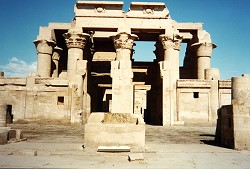
Kom Ombo (Nb(j)t) is situated on a cliff in a bend of the Nile, on the north side of a fertile area. It lies on the border between the Arabic and Nubian language areas, and is also an important stopping place on the desert routes. Almost all the monuments date from the Ptolemaic Period, when this area became important thanks to improved agricultural techniques. There was building activity here earlier, however, two blocks dating to the Middle Kingdom have been found for example, and Champollion discovered a gate dating to the 18th Dynasty in the southern boundary wall. The earliest king to be mentioned is Ptolemy VI Philometor, and the majority of the decoration was completed under Ptolemy XII Auletes. The forecourt was decorated in the early Roman Period and an entrance was added.
The most striking thing about this temple is its double structure - it has double gates and a double axis leading to a double sanctuary inside. The temple is dedicated to two triads, that of Sobek, Hathor and Khons, and that of Haroeris (Horus the Elder), Tasenetnofret (the good sister) and Panebtawy (the lord of the two lands). The last two names refer more to functions than to identities, that is, to the female and child elements of a triad. In addition to the daily (double) cult, there were processions from the temple to the necropolis where the 'dead gods' were buried - Re, Geb and Osiris, all three of which were regarded as forms of Sobek. The temple reliefs indicate that the temple had a very complex theology as far as the relationships between the various gods were concerned. Near the river is a birth house or mammisi, whose reliefs depict the ritual of 'shaking the papyrus', among other things. The link between the 'room of the inundation' and the 'ahet weret', where the divine marriage between Shu and Tefnut took place, is also striking.